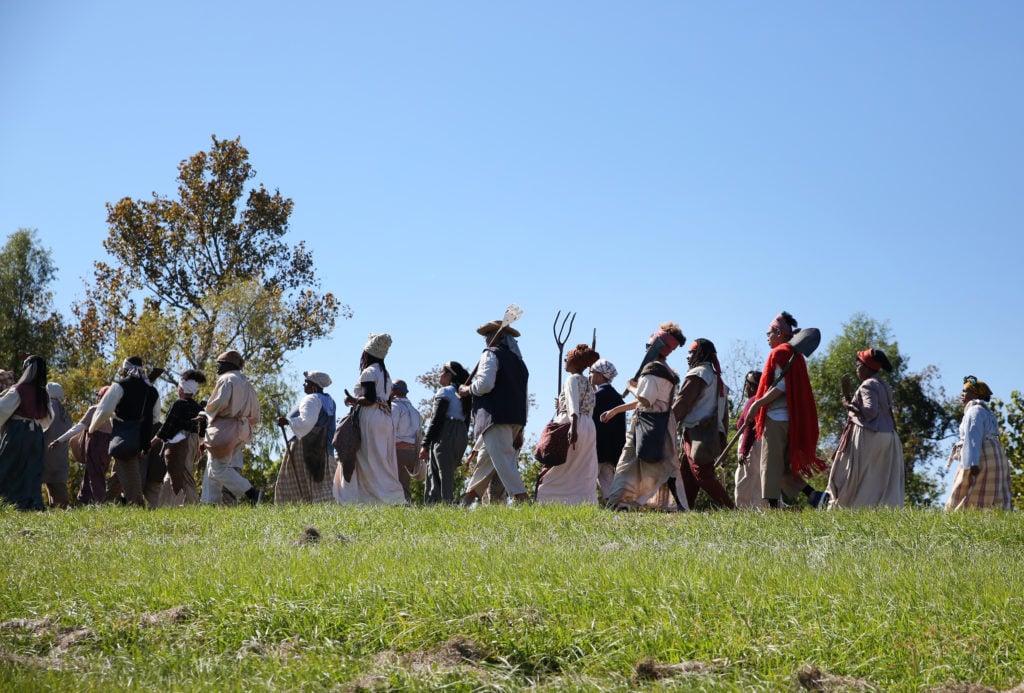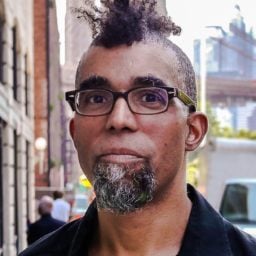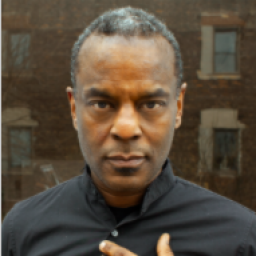They were told how to walk. And how to use their weapons. In rehearsals, marchers were fitted for their costumes and placed in formation, then taught to move as a group while chanting phrases including “On to New Orleans!” and “Freedom or Death!” in honor of a slave rebellion that scholars now recognize as the largest ever in American history.
Some 400 performers spent this past weekend staging a reenactment of the German Coast Uprising of 1811, when a wave of enslaved rebels marched from sugar plantations east of the Mississippi River to New Orleans, burning plantation houses along the way.
The performance was the handiwork of New York-based artist Dread Scott (whose own name is a reference to Dred Scott, the enslaved man who sued unsuccessfully for his freedom in 1857). Slave rebellions had long been on the artist’s mind, but this one had completely missed his radar. Before he learned about it six years ago, Scott had been contemplating staging a hypothetical revolt featuring black history’s most prominent insurgents, like Nat Turner and Gabriel Prosser. Then he found out about what had happened in Louisiana in 1811.
A Forgotten History
Black history is everyone’s history, except when it comes to the enslavement of generations of black people. By now, the dismissal of the subject as ancient history is far too common. “To quote a comedian, every time you try to talk to some white people about slavery, it’s 100 years further down the road,” says John McCusker, a veteran photojournalist who spent years covering St. John the Baptist Parish, the black-majority area in the outskirts of New Orleans where Scott’s march begins.
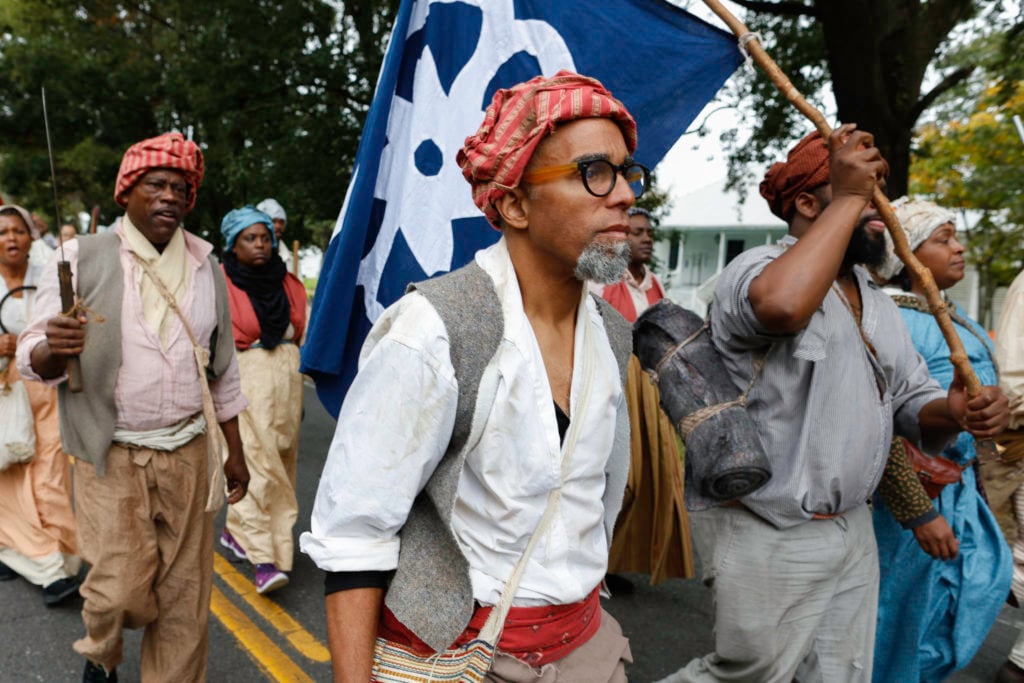
Dread Scott leading the “army of the enslaved” making its way across the 26-mile path through Louisiana. Costumes designed by Alison Parker, Photo: Soul Brother. Courtesy of SRR.
Scott is well versed at creating art that makes people pay attention. An installation he developed as a student at the Art Institute of Chicago that appeared to encourage viewers to walk on the American flag inspired protest and even efforts to make it illegal to display a flag on the ground. But historian Laura Rosanne Adderley worries that he will have a harder time igniting a conversation about slavery, as Americans generally feel no need to reckon with it.
“There is a good bit of discussion about race and racism,” she says, “which very often focuses on ethics and the personal prejudice in the heart of this person or the next person. There is not yet, however, an understanding that at the center of this is how we are not talking about black enslavement.”
Within the first hour of the reenactment, McCusker, in character as plantation owner Manual Andry, was gone. A small group of rebels had him surrounded on the porch and after pleading to be spared, they launched their attack. (In the end, though, Andry managed to escape by fleeing towards the Mississippi River.) From there, the army of the enslaved grew in size, just as it had when more and more slaves from sugar plantations on River Road joined in on the fight. Some re-enactors were on horseback, others were walking with flags, and more still were playing instruments.
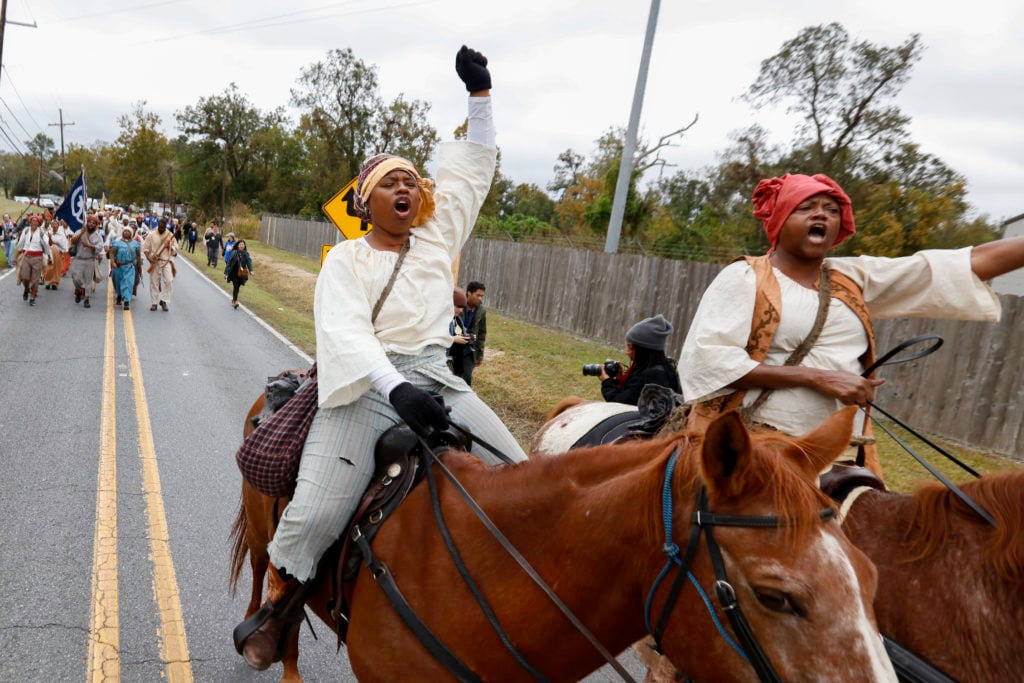
Reenactors marching across the 26-mile path through Louisiana. Costumes designed by Alison Parker, Photo: Soul Brother. Courtesy of SRR.
The scene was more joyous than the event that inspired it, although its sheer scale lent a dose of somber, collective remembrance. These performers came together to represent a time in history when hundreds of black people firmly held onto the belief that they had a chance to win their freedom.
Pulling It Off
The project was not easy for Scott to get off the ground. Soon after he began to develop his large-scale ambitions, “Trump started to rise,” he says. “And then a lot of funders became very interested in flipping Congress in 2018.”
In the end, Scott managed to assemble a group of at least 12 institutional stakeholders who agreed to finance a large-scale ephemeral artwork, despite the fact that he has no plans to repurpose it for display in a museum and it wasn’t “initiated by somebody like Kara Walker or Ai Weiwei,” artists with a proven ability to draw a mass audience. He also pursued scrappier fundraising initiatives, including a Kickstarter campaign and a tour around New Orleans for individual donations.
“I think that it’s an important model for thinking about how institutions are supporting art moving forward,“ says Deborah Fisher, executive director at the nonprofit A Blade of Grass, an early investor to the project. “What he had to navigate is the fact that his vision far outstripped the capacity of just about any partner who was willing to partner with him—by a lot.”
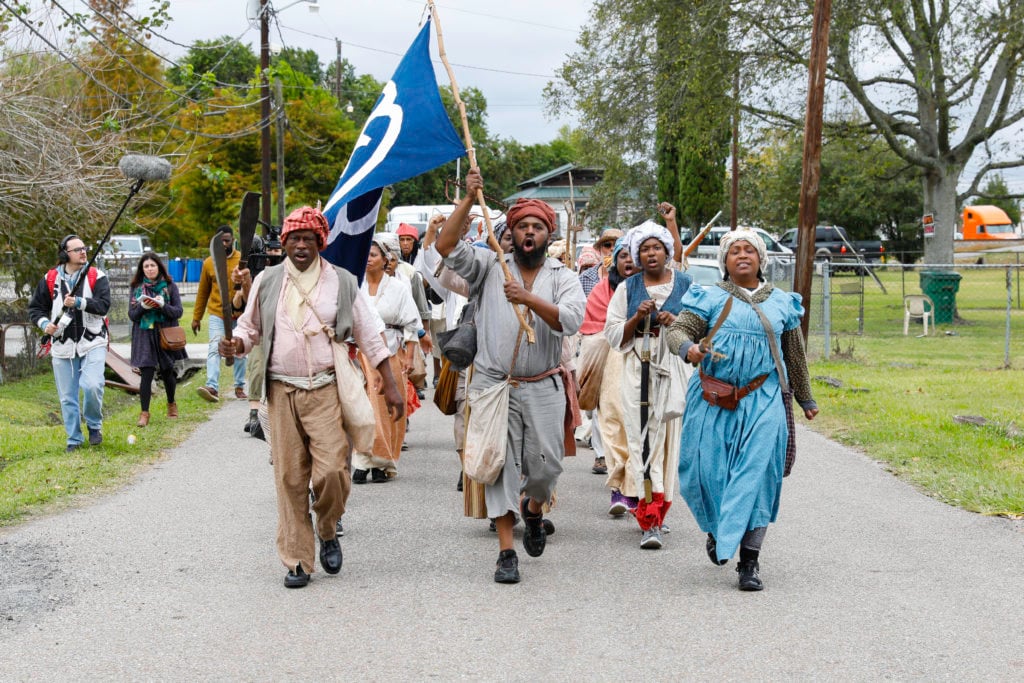
Participants marching across the 26-mile path through Louisiana. Costumes designed by Alison Parker, Photo: Soul Brother. Courtesy of SRR.
The final $1 million-plus price tag for the event exceeded not only the annual budget of her organization, but also that of the New Orleans-based non-profit Antenna, whose founder Bob Snead worked hand-in-hand with Scott to pull it off.
Apart from Scott’s outreach efforts, which included familiarizing himself with the river parish communities and participating in discussions about the re-enactment with students at local colleges, putting together this performance was much like organizing a low-budget film: Antenna’s community organizer Karen Kaia Livers launched a casting call over the summer to secure participants and Snead handled most of the on-the-ground logistics, like acquiring the necessary permits and setting up a production schedule.
On her first day on the job, Livers called the council of elders at the river parishes to rally their support—and to also share the news that the story of their ancestors, which had long existed only as local lore, was finally going to get the attention it deserved.
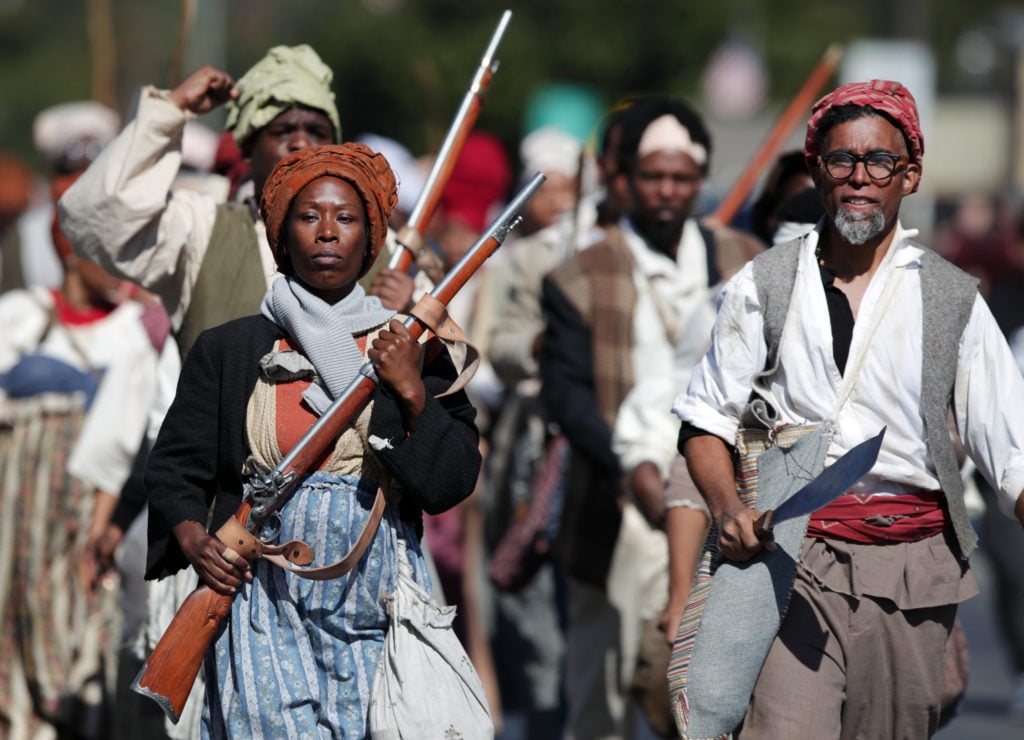
Reenactors retrace the route of one of the largest slave rebellions in U.S. history on November 09, 2019 in New Orleans, Louisiana. (Photo by Marianna Massey/Getty Images)
Reconstructing the Story
With such a charged and monumental history, there was a lot at stake for Scott to get right. But because this story had been largely overlooked by traditional history books—and because many of the narrators who did record it were unreliable—Scott had to rely on historians’ educated assumptions when piecing together idiosyncratic details like period-appropriate dress and the size of the insurgency.
And since the only evidence they had about the uprising was assembled by those who were suppressing it, “they had no incentive to raise these numbers high,” Adderley, the historian, explains. “So we’re pretty confident about 500 people being involved in this, probably more.”
They also read in between the lines when it came to envisioning the march’s formation. Given the inclination of white enslavers to paint groups of black people as “scary and disorganized,” Adderley says, “if militia forces said that they were very organized in march formation, we can also more or less take that as true.”

Part of the Slave Rebellion route through Louisiana. Courtesy of SRR.
Above all, Scott’s biggest concern was rendering the vision of the rebels faithfully. Early on, he recruited local historians Leon Waters and Malcolm Suber as consultants. Waters was responsible for publishing historian Albert Thrasher’s On To New Orleans: Louisiana’s Heroic 1811 Slave Revolt—the first written account of this otherwise forgotten event.
“The lesson here is that black people never accepted their own enslavement,” says retired Tulane University professor and historian Lawrence Powell, describing the heroism of this multiethnic group, who didn’t all speak the same language, as proof of “black humanity, black valor, [and] black self-dignity.”
While the rebels’ objectives are still “not entirely clear,” says NYU professor Steven Hahn, the fact that they were politically motivated certainly is. “Was it a vision of ending slavery?” Hahn asks. “Or a vision of ending slavery for themselves? Either way, [the rebellion] becomes part of the new political mix in North America.”
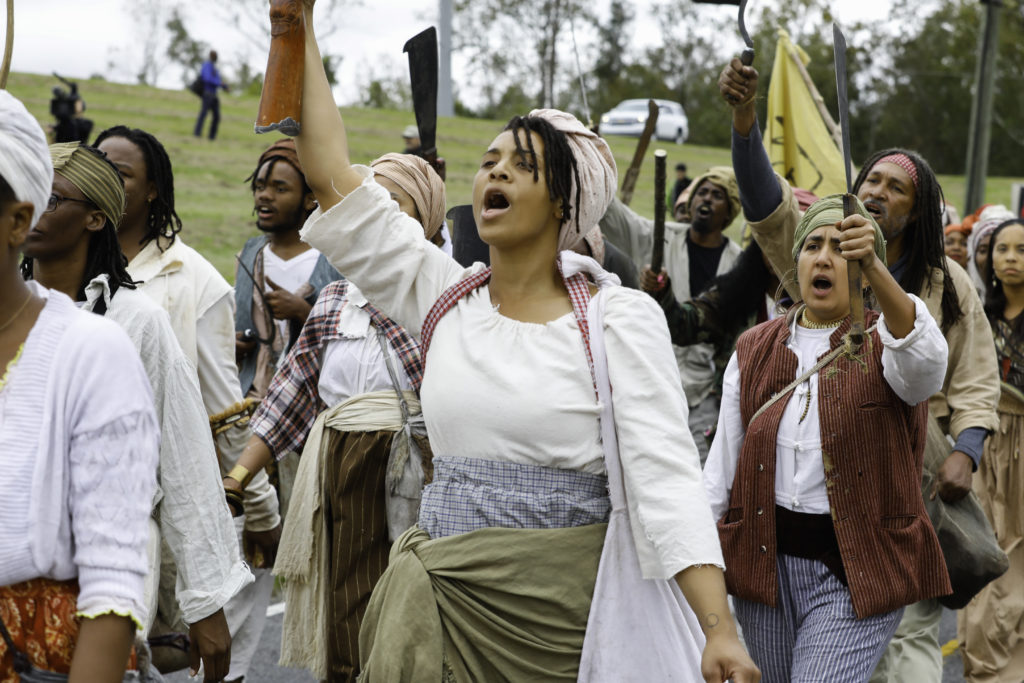
Participants marching across the 26-mile path through Louisiana. Costumes designed by Alison Parker, Photo: Soul Brother. Courtesy of SRR.
The event organizers rallied behind this interpretation. “They could have all just planned to run away,” Livers, the community organizer, says. “But they didn’t. Their plan was to take over the government and demand maybe an area that could be given to them—for their freedom.”
At the time, that was a very radical idea.
An Alternative Ending
While Scott’s version of the performance sought to hew closely to history, he knew the ending had to change. Instead of replaying the rebellion’s brutal conclusion, in which the heads of nearly 100 black people were propped up on pikes along River Road, Scott orchestrated a late-day skirmish in which the rebels confronted the white militia and forced their retreat. Adamant that the revolt “had a chance of success,” he says, the second day of the performance ended with the slave army celebrating their victory in the center of New Orleans.
Not every historian interprets the events this way. While many agree that news of the success of the Haitian Revolution inspired hope among the rebels and set their plan in motion, Powell doesn’t believe victory was in the cards. He maintains instead that the uprising’s brutal ending offers an important—if ugly—truth about America’s past.
“It was early American power that smashed that slave rebellion,” he says, noting that at the time Louisiana was a territory independent of the United States, so not assured of Washington’s help. “And I think that sent reassuring messages that finally [Louisianians] were under a metropolitan power that will do everything and anything it can to defend the institution of slavery.”
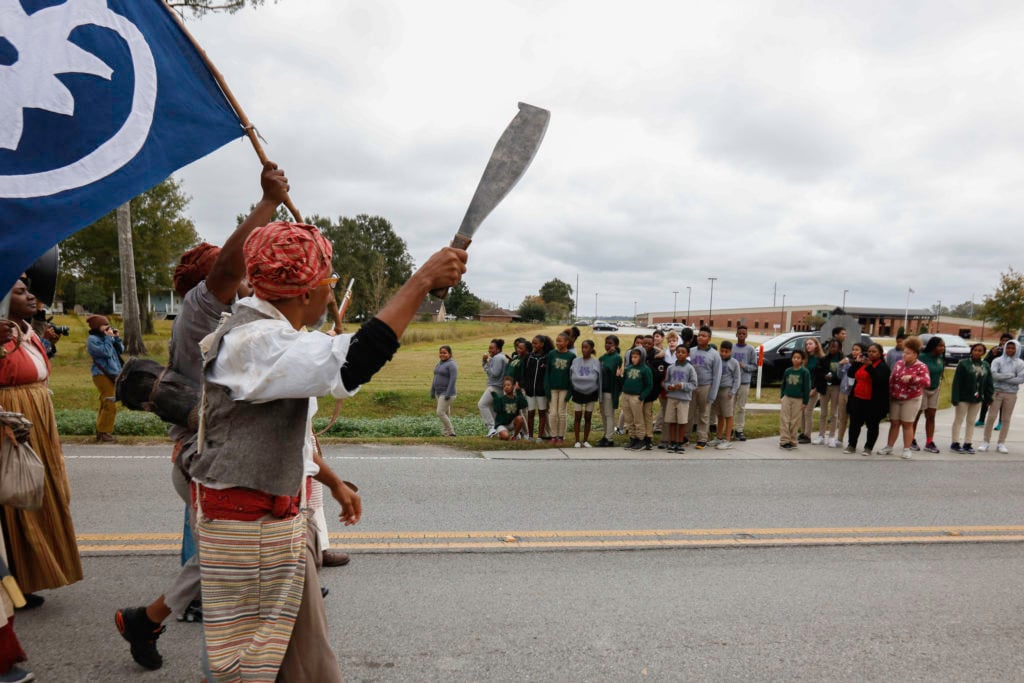
Dread Scott leading the “army of the enslaved” making its way across the 26-mile path through Louisiana. Costumes designed by Alison Parker, Photo: Soul Brother. Courtesy of SRR.
People often cite Louisiana’s status as a territory in 1811 as the reason why no one, until Thrasher, considered the rebellion important enough to write about, even though it was “a real symbolic turning point,” Powell notes, in the nation’s grappling with slavery.
Adderley sees the name assigned to it as another possible setback to proper commemoration. “Every time I hear someone refer to this as the German Coast rebellion. I want to stick a pen in my eye,” she says, “[because] it muddles what you are talking about as it’s not a term that’s in common usage today.“
In an odd twist of fate, however, there is now a new name that carries on this legacy: Dread Scott.
